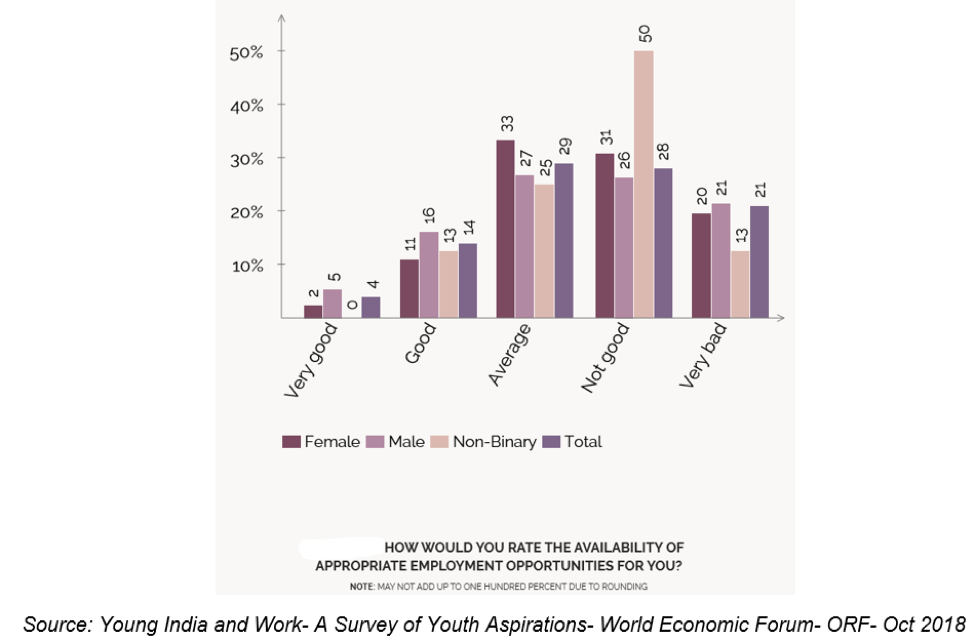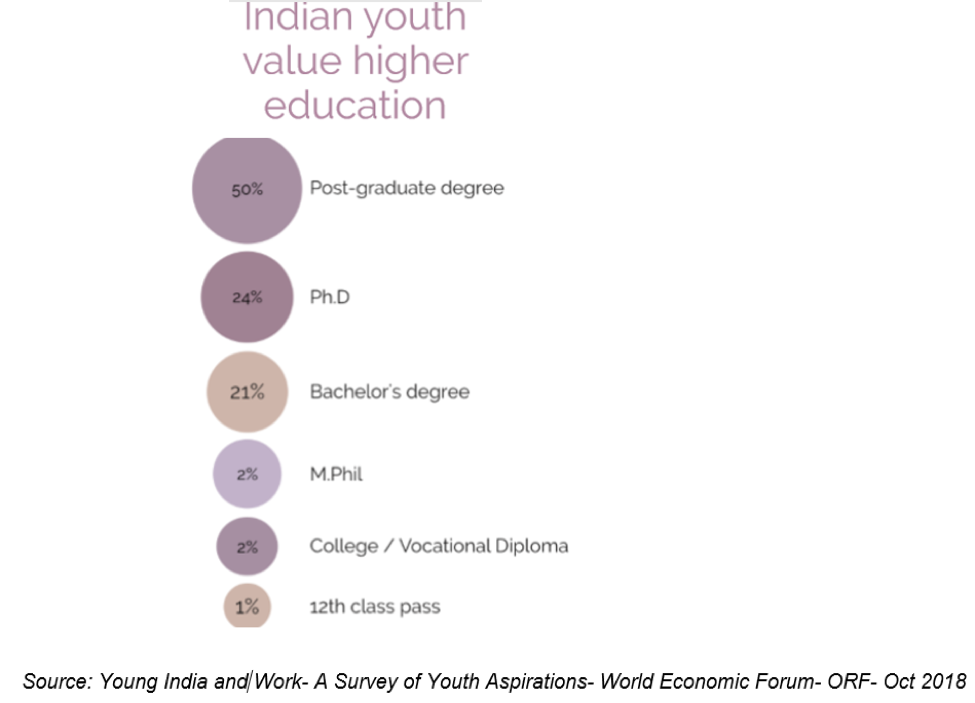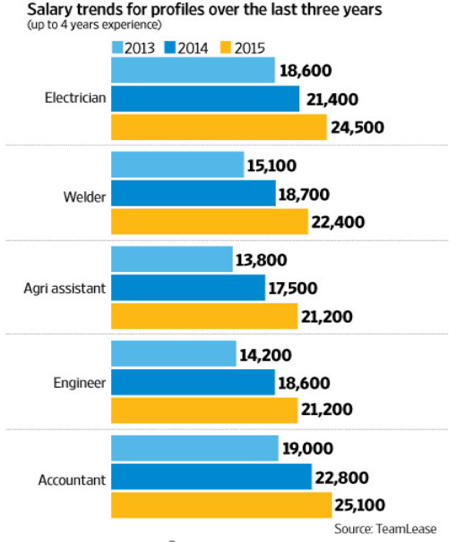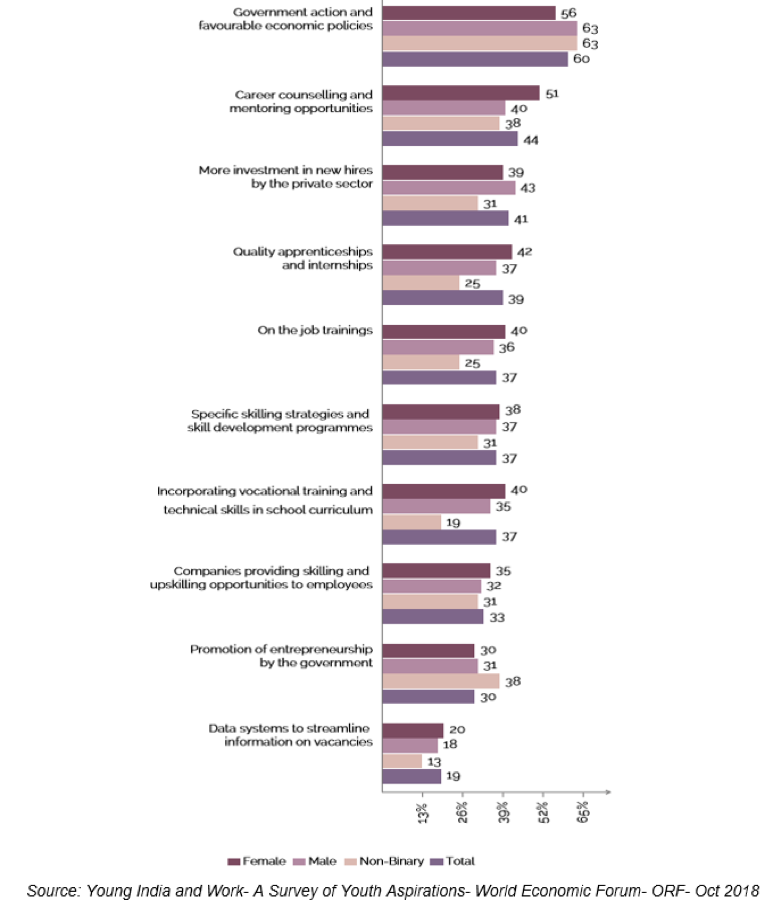76 percent of youth are very interested in pursuing skill development training and a whopping 81 percent consider internships or apprenticeships important for getting hired. So what are we waiting for?
These are findings from the Future of Work in India report[i] and its related publication Young India and Work- A Survey of Youth Aspirations.[ii] Published in October 2018 these reports turn the spotlight on what youth are aspiring for, what they value most, the challenges they face, and what businesses and decision-makers can do to bridge gaps. These should be of interest to industry and policymakers to chart out ways to effectively engage this heaving mass of young and eager populace who given the right opportunities can become an economic powerhouse.
With more than 62 percent of its 1 billion-plus population in the working age group (15-59 years), and more than 54 percent below 25 years of age, India enjoys what has been called a demographic dividend. But is it really the case. Estimates vary between 12-15 million for youth entering the workforce every year and over 75 percent not job ready owing to a severemismatch of skills between education and industry needs.
Both above-stated reports conducted a survey of 774 companies across India and more than 5,000 youth between the ages of 15 and 30. Data was collected from Andhra Pradesh, Assam, Maharashtra, Odisha, Uttar Pradesh, West Bengal, and Delhi to closely match the overall urbanisation rate of India at 29 percent. Admittedly the sample size may not be statistically significant but the findings have merit in throwing light on some of the most crucial issues facing the country.
When asked reasons for being interested in skills training, 70 percent of respondents who were very or moderately interested in skills development believed that skills training would boost their employability, 48 percent cited increased pay and 44 percent said getting more skilled in their area of study as the main reason for their interest.
On the flip side, 72.5 percent of respondents reported being unaware of government-run skills development programmes in their area. And 77.5 percent of youth said they had never enrolled in a skills development programme.
Other revelations were:
- Lack of guidance and counseling in identifying jobs matching their skill sets was stated by 51 percent of youth as the main barrier when seeking employment, while lack of work experience was the main barrier reported by 41 percent.
- A shout out to industry- 49 percent of youth reported that the most valuable form of guidance was interaction with industry professionals
- Close to half of youth discern the availability of appropriate employment opportunities to be not good or very bad with 29 percent stating it to be average.


- Indicative of a low value attached to vocational training, although 76 percent of youth are very keen in skills training, only 2 percent aspired to a vocational diploma as their highest form of education for an ideal job, whereas 50 percent sought a post-graduate degree, 24 percent a PhD, and 21 percent a bachelor’s degree.




- For 80 percent of youth monetary compensation such as a stipend was important from a skilling programme, whereas 71 percent stated that the ideal training would lead to a certification. The schemes of training and apprenticeship offered by the government provide reimbursement towards stipends to employers and nationally recognised certification which we have detailed in our blog A Toolkit for Employers – Part I and Part II
- Youth state a preference for a blended learning approach- online and on-site training. However, they are prepared to commit only a moderate amount of time towards skilling with a preference for shorter duration skill programmes. This goes against an overwhelming belief (81 percent of youth) that an internship or apprenticeship are important for getting hired. Perhaps there is a glaring lack of awareness about the differences between an internship and apprenticeship, and why a minimum of a year’s commitment is essential for an apprenticeship to acquire superior skills. This may even stem from an inherent flaw in the education system where one is unable to pursue both higher education and skills training in parallel or there is limited mobility between the two streams. However, the National Skills Qualification Framework now allows such flexibility although how much of it is in practice remains to be seen.
Case for Apprenticeships
- With 44 percent of youth stating that technical and hard skills are highly received by employers, along with work experience, and 53 percent felt that the training should be inter-linked with hands-on experience, this is a strong case for introducing apprenticeships.
- Again, 63 percent of youth reported gaining job-specific skills would be useful along with 43 percent citing workplace visits will be insightful. An apprenticeship or industry training caters to all these needs along with the option of being absorbed as a permanent employee at the end of the training period.
- 19 percent of surveyed companies hired independent workers in the past year due to their inability to find permanent skilled staff. With the government making many industry-friendly changes to the Apprentice Act and offering multiple benefits, it’s time more employers seek out the apprenticeship route to build in-house talent. Youth receive high-quality mentorship and training and companies get a potential job ready employee; it’s a win-win situation.
- There exists a clear mismatch between the work aspirations of youth and industry demand. Organisations expect the highest increase in recruitment in the next five years in roles such as customer services, sales, IT support, accounting and auditing. Youth are however more attracted to jobs in administration and support activities, R&D, creative industries, training and development, HR and recruitment. Of course, this data is not representative of the entire youth population or all enterprises but is nevertheless insightful as it is suggestive of the glaring issue of supply-driven employment leading to millions of youth not finding work suited to their skills.
What Companies Can Do
Indian employers often bemoan the lack of skilled workers. However, the big chunk of the onus also falls on businesses to invest resources and effort in on-the-job training. The industry should be playing a much greater role in the supply chain of skilled workers through greater participation with academic institutions and training providers to establish robust skill-building programmes such as apprenticeships. Youth need to be aware of where the demand is and which skills will be useful. Policy makers at the government level are often removed from the realities of the labour market. Hence industry needs to lead from the front through increased participation. As felt by 41 percent of youth,ii a higher involvement in skills training including apprenticeships and uptake of new hires by the private sector would help close the gaps between their aspirations and available opportunities.


Increased Online Presence
The proliferation of social media and internet connectivity means that mobile and web platforms are the fastest and the most far-reaching tools to reach youth. 81% of survey respondents use the internet to seek out information about employment opportunities. In contrast, only 14 percent of surveyed firms were using online recruitment channels. Employers need to do much more to amplify and broaden youth awareness on employment opportunities and skill development programmes through online and mobile sources.
Action Required
The private sector needs to turn up the notch on engaging India’s youth in skill building. Lamenting lack of skills is not a privilege of any stakeholder if no action is taken to be part of the solution.
The latest NSS (68th) report[v] which is a far more representative survey of the country in terms of coverage, reported that only around 2.4 percent of youth in the age group of 15-29 years had received any formal vocational training. Flagship schemes such as Skill India, Make in India, the National Apprenticeship Promotion Scheme are all laudable but a policy is only as good as real output on the ground. To leverage India’s young and vibrant demographic dividend, a proliferation of high-quality accessible training opportunities is needed. Notwithstanding the government’s role in boosting vocational opportunities, the private sector has a crucial role in taking fire from the sparks to a blaze to make training initiatives demand-driven. Youth want to get skilled, 76 percent of them. Estimates state that India must create more than 8.4 million jobs a year to maintain its current employment rate. It’s time forthe industry to open their doors.
References
[i] The Future of Work in India, Oct 2018, Observer Research Foundation, World Economic Forum
[ii] Young India and Work- A Survey of Youth Aspirations, Oct 2018, Observer Research Foundation, World Economic Forum
[iii] When electricians earn more than engineers, Apr 2016, LiveMint
[iv] Footnote– The engineering colleges considered for the study were ranked 50- plus in the Outlook engineering college rankings and MBA colleges 40-plus by Business Today B-school rankings
[v] Status of Education & Vocational Training in India, NSS 68th Round, June 2011- July 2012, National Sample Survey Office, Ministry of Statistics & Programme Implementation














